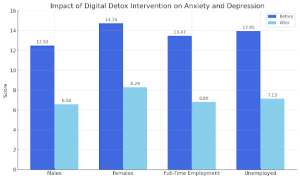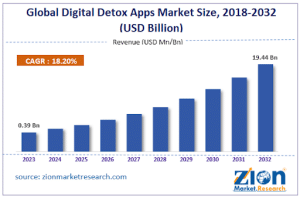These days, the stream of digital information seems never ending. Most of us are constantly connected, blurring the boundaries between work and personal life. Being permanently connected can lead to burnout, decreasing employees’ productivity and well-being. Awareness of this issue is increasing among employers, who are implementing digital detox initiatives to help employees recharge and maintain mental clarity.
As remote work and always-on expectations continue to grow, employees often struggle to disconnect, leading to chronic stress and declining productivity. Digital detoxes can provide balance to an over-stressed life, improving focus, recharging energy, and enhancing team dynamics.
This article examines the benefits of unplugging, outlines how to implement successful detox programs, and discusses how employers like you can integrate digital well-being into their long-term company culture to enhance mental health and workplace performance.
The Hidden Toll of Always Being Connected
Constant connectivity has a price: rising anxiety, poor sleep, and decreased cognitive function. The compulsion to stay online — even after work hours — has blurred the boundaries between personal lives and professional demands. Employers need to recognize the mental and physical consequences of digital overload: excessive screen time contributes to burnout, insomnia, and mental fatigue, and it decreases focus and harms productivity. Always-on culture fosters presenteeism, not performance.

What’s a Digital Detox?
A digital detox is an intentional pause from electronic devices such as smartphones, computers, tablets, and social media with the intent to reduce stress and support mental well-being. This practice encourages individuals to temporarily disconnect from constant notifications and screen time, creating space for rest, reflection, and real-life connection.
Whether it’s for a few hours each day or a longer stretch, digital detoxing can help improve focus, enhance sleep quality, and promote healthier routines. That’s why interest in digital detox initiatives and solutions has increased in recent years.

Examples of digital detox initiatives include:
- No work emails outside working hours, or on weekends
- Focus filters on office computers
- No-devices relaxation areas
- Digital detox retreats
- Incorporating digital detox applications into corporate wellness programs
How to Design Digital Detox Programs That Actually Work
Creating an effective digital detox initiative requires thoughtful planning, clear boundaries, and flexibility. These programs should encourage breaks without penalizing productivity, offering structured and voluntary ways for employees to unplug.
- Offer tech-free zones or meeting-free days
- Encourage scheduled email breaks or offline hours
- Support “focus time” with tools like Do Not Disturb settings
- Provide alternatives: nature walks, quiet rooms, or creative time
- Make detoxes inclusive — adaptable for both remote and in-office staff
Get Buy-In, Not Pushback: Inspiring Employees to Unplug
Employees may resist unplugging due to fear of missing out or being seen as unproductive. The fast-paced work rhythm can drive resistance from management and employees.
“In our industry, we cannot afford to be disconnected” is a common argument made by technology or fast-paced companies. You can solve this problem by setting protocols to escalate issues by urgency and priority.
Management should run point, modeling behavior, communicating benefits, and emphasizing that digital rest is a performance strategy, not a weakness. Here are some messages to convey:
- Communicate the value of rest and recovery to performance
- Train managers to support and encourage disconnection
- Share success stories from early adopters
- Recognize participation to normalize the practice
- Make digital detox part of wellness incentives and challenges
Embedding Digital Well-Being Into Workplace Culture
True change requires a shift in values. Digital well-being should be integrated into policies, leadership expectations, and team habits — not just offered as a one-time campaign.
- Small changes make a great impact. You don’t need to completely change your company culture overnight. Implementing screen-free time or organizing digital detox retreats can be a good place to start.
-
- Develop screen-time guidelines in internal communications. Make digital boundaries part of your culture. For example: No work communication outside office hours.
- Encourage tech-life balance in performance reviews. Include digital wellness in onboarding and training.
- Celebrate tech-free time as part of a healthy workplace identity. Provide education and tools within your wellness program, organizing workshops and distributing information.
Long-Term Strategies for Digital Well-Being
Sustainable digital well-being takes ongoing support and thoughtful planning. As technology continues to evolve and integrate into nearly every aspect of work and life, organizations must ensure their approach stays people-centered, adaptable, and preventative — not just reactive. Long-term strategies should evolve with technology while maintaining a human-first focus.
- Regularly evaluate employee screen time habits and provide feedback. Use digital analytics tools to identify patterns, then help employees make informed adjustments that support focus and reduce fatigue.
- Invest in mental health tools and platforms that track stress and engagement. These solutions can provide early indicators of burnout, helping employers intervene before productivity and morale decline.
- Partner with wellness tech providers for continuous improvement. Collaborating with experienced vendors ensures your programs stay current with the latest research and tools in digital well-being.
- Offer ongoing education around digital balance and mindfulness. Workshops, webinars, and internal campaigns can build awareness and equip employees with practical strategies to manage screen use more intentionally.
- Reinforce habits through monthly wellness check-ins and manager-led reminders. Consistent engagement from leadership helps normalize healthy tech habits and keeps digital well-being a visible, shared priority.
Reboot Workplace Wellness With CoreHealth
As screen time continues to rise, companies must address digital overload to protect employee mental health and performance. Long-term digital well-being starts with a cultural shift, supported by leadership and the right tools. Platforms like CoreHealth can be integral in this transformation — offering personalized wellness tracking, mental health resources, and engagement tools to help employees manage stress and avoid burnout.
With CoreHealth’s technology, organizations can create a workplace where unplugging is not only accepted, but encouraged. Contact the Corehealth experts today.
Learn more about wellness programs with these articles from the Corehealth blog:
5 Effective Strategies to Reduce Workplace Stress and Enhance Employee Well-Being
3 Reasons Workplace Stress Management Plans Fail and How to Fix Them
How to Incentivize Healthy Behavior at Work